September 14th, 2015 · 3 Comments
We’ve been on 3 ferries in the past 48 hours, a Papa, a Mama, and a Baby ferry.
The Papa lasted about 7 hours, and brought us from Newfoundland to Nova Scotia. The Mama lasted a little over an hour and took us from Nova Scotia to Prince Edward Island. And the Baby just took us on a short cut across a strait on Nova Scotia, and lasted less than 5 minutes.
We’ve decided to include a piece of New Brunswick in our tour. The Bay of Fundy National Park is in New Brunswick and could be the best place to see the tides. It’s only a couple of hours out of our way anyway.
Canadian geese honking in the distance as I write this. Nova Scotia is about 10 degrees F warmer than Newfoundland. 77, rainy and cloudy today, supposed to clear tomorrow.
Tags: Uncategorized
September 11th, 2015 · 1 Comment
We spent the past two nights in Gros Morne National Park, though in retrospect we should have set aside an extra day or two. It’s quite spectacular, comparable I think to Yosemite.
There are two main features. In the south where we stayed there’s an area where the earth’s mantle has pushed up through the crust, creating a barren brown rocky mountain called the Tablelands. The chemical composition of the mantle is not conducive to plant growth, so there are only a few small adapted plants growing through the brown rocks. As you drive into the valley the contrast between the brown mountain on one side, and the lush green on the other is striking. Unfortunately it was too foggy for me to get a good picture of both sides. I’ll try again on my way out and if successful I will post it here.
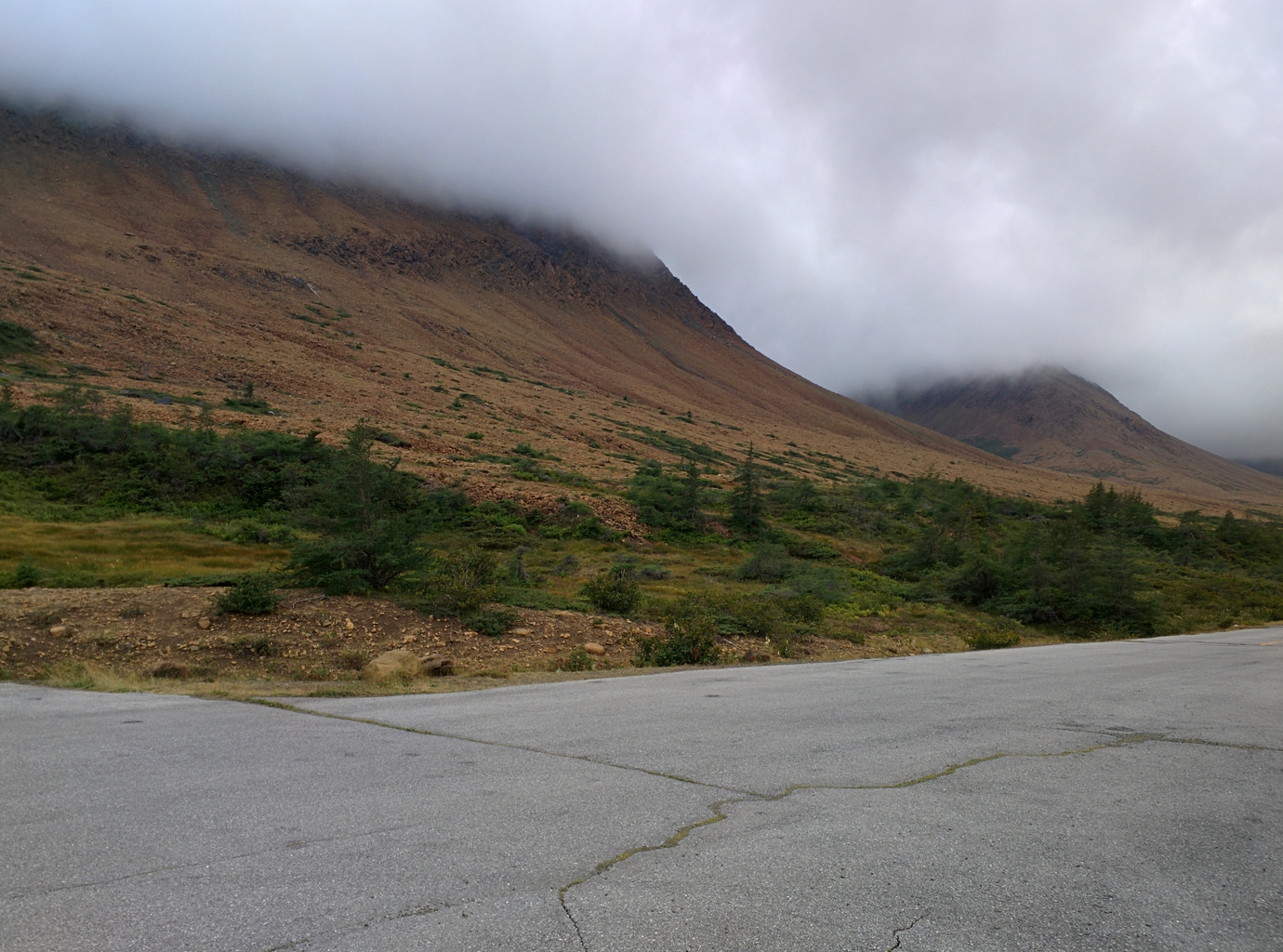
We went on a ranger-guided walk into the Tablelands and were told that the rocks here are around 500 million years old, much older than most rocks on the surface of the earth. Geologists come from all over the world to study the rocks here.
The other striking feature of Gros Morne is the fjords, or sounds. Again, it was too foggy to get a good picture, and we didn’t have time to get closer. With an extra day we could have taken a boat ride deep into the fjord that you can see in the distance, covered here by fog. Of course, even in a boat the fog would have been a real damper on the views.
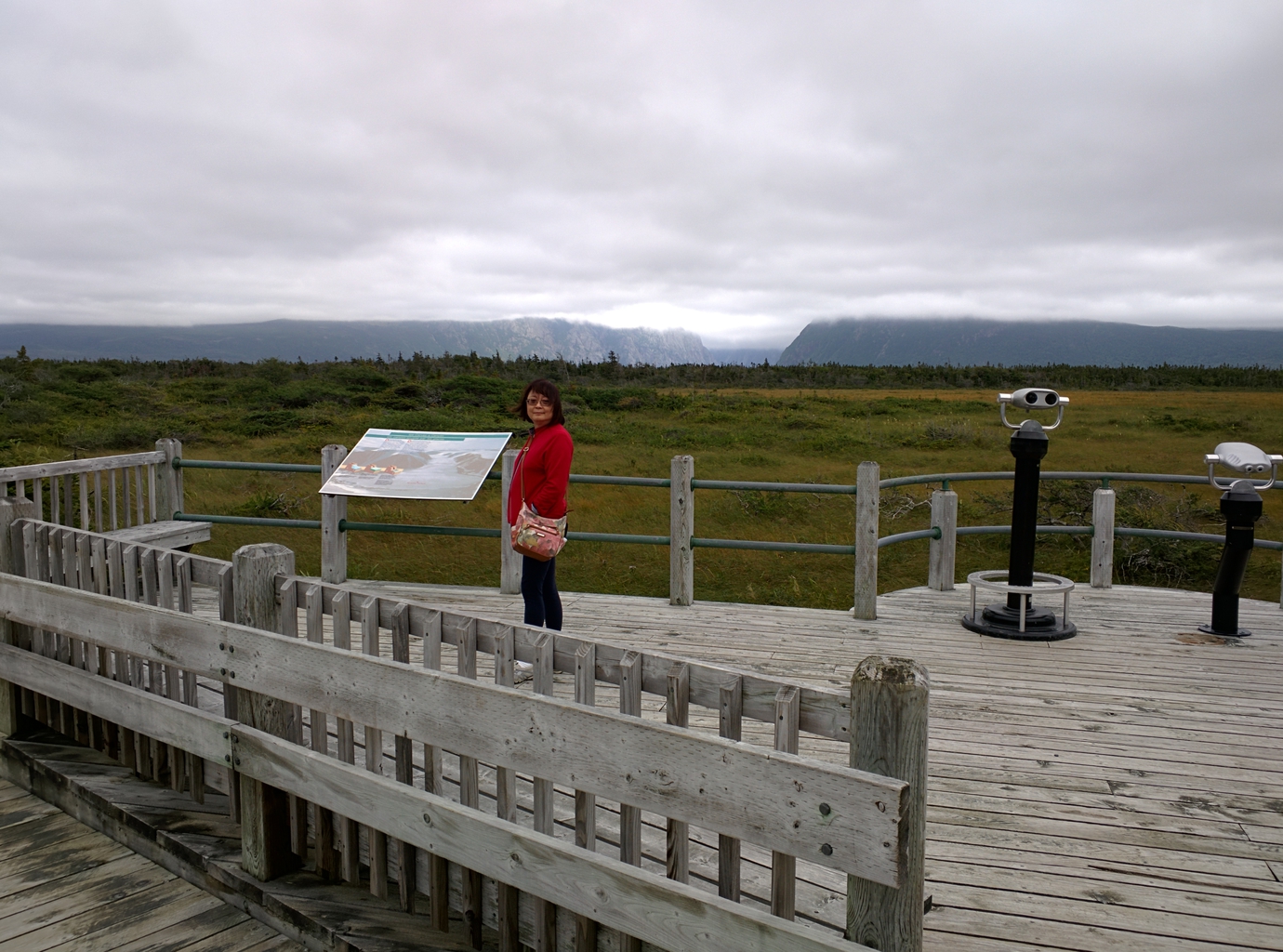
Today we leave Gros Morne and drive down to take the Ferry to Nova Scotia. Our ferry leaves at 11:45 this evening and arrives in Nova Scotia around 8:00am. We got a room with a couple of beds and hope to get some sleep.
We’re also hoping that tropical storm Henri waits until we are safe on land before arriving.
Tags: Uncategorized
September 11th, 2015 · 1 Comment
One province, with a compound name. Established in 1949 as simply “Newfoundland”, the name was changed in 2001. In general conversation Canadians refer to the province as Newfoundland, but in all official discussion the full name is used. Practically, the island is always “Newfoundland”, while the mainland portion is often just “Labrador”.
I had always pronounced the island “New-Fund-Lund”, but I hear locals say “New-Fund-Land”, saying “Land” like we would in isolation. So that’s how I’m trying to say it.
Talking with some Torontons last night, they said that “Newfies” are often the brunt of jokes in metropolitan Canada, I think like the old Polack jokes we used to tell, or blonde jokes. “How many Newfies does it take to screw in a light bulb?” I’m sorry to say that I don’t know the answer.
Tags: Uncategorized
September 7th, 2015 · 2 Comments
Staying another night in the Ocean View park near Leading Tickles, although the weather has turned chilly, cloudy and rainy. The camp hostess thought we would leave with everyone else because of the weather, but we told her it will be raining anywhere we go, so we might as well stay where it’s so beautiful.
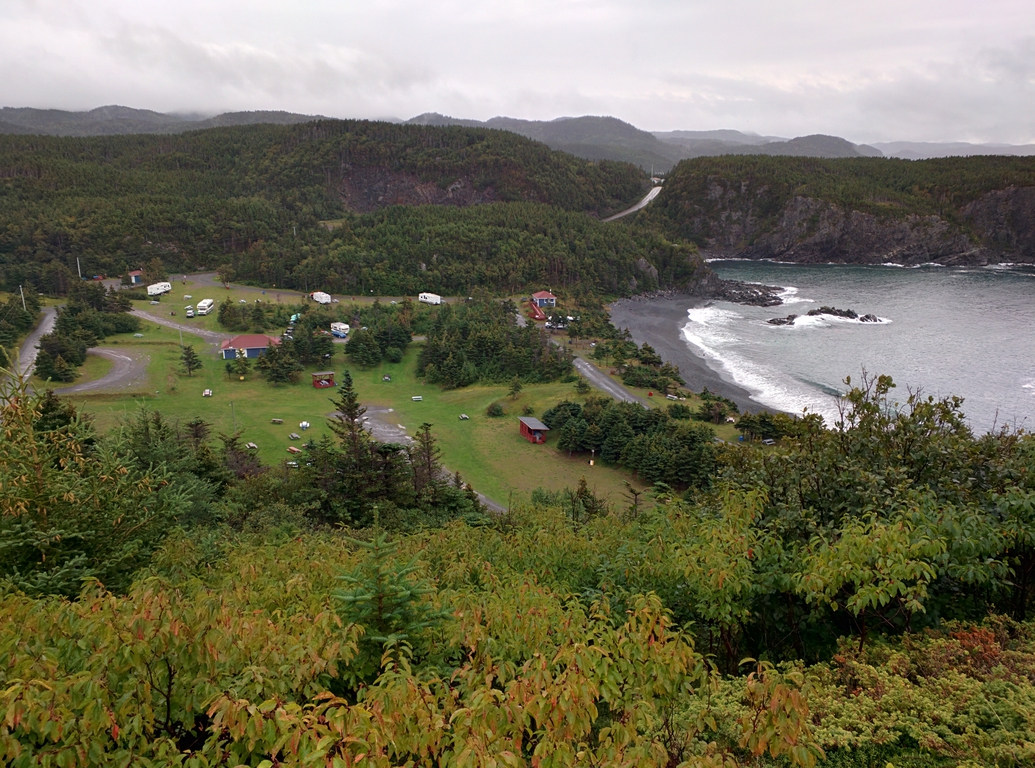
I hiked up to the top of the hill and took this picture of the park. You can just make out the white of our RV through the trees next to the beach. It’s right in front of the red building.
There’s another very similar beach just outside the picture on the left. The park is on a peninsula.
We went over to the snack bar where the lady was preparing to shut down for the season. She gave us a free ice cream cone.
Tags: Family Updates
September 6th, 2015 · 3 Comments
We are spending our third night near the village of Leading Tickles, on the north coast of Newfoundland. Our campsite is less than 100 feet from the ocean surf, which should lull us to sleep tonight. It’s the nicest of the three places we have stayed. (A Tickle is Newfoundlandese for a small, narrow strait, we found out.)
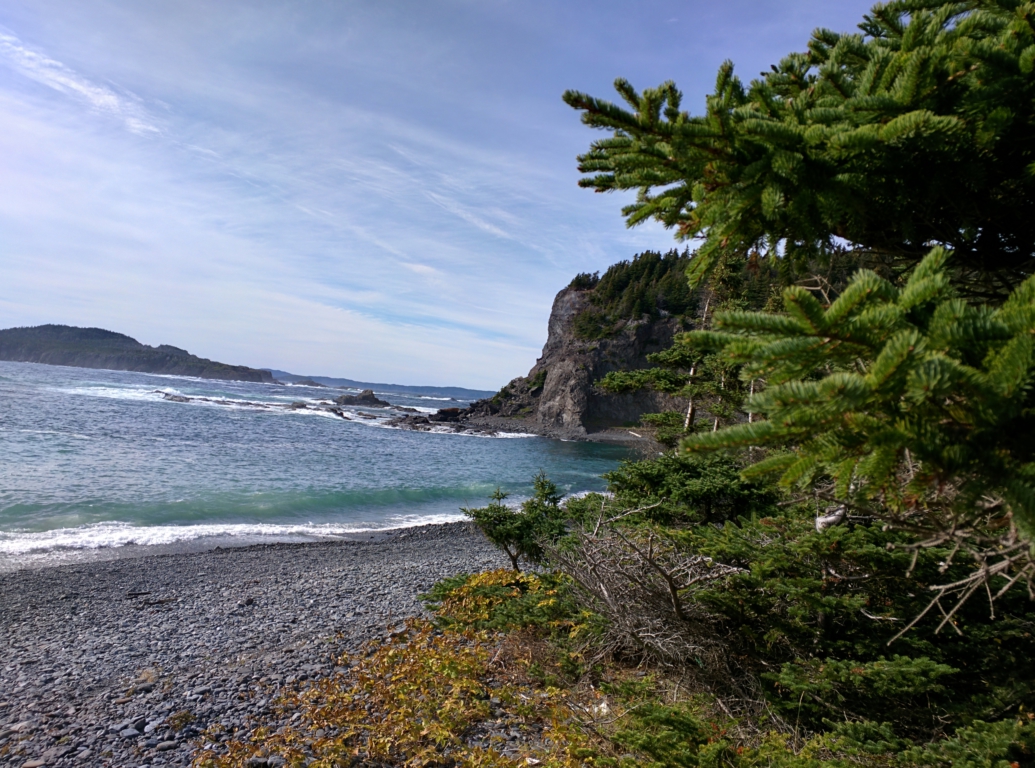
On the first night we just pulled off the road near “Came-by-Chance” by a historical sign and dry camped; no water, electricity or sewer hookup. But our RV is self-contained so it was no problem. The second night we stayed in a very nice RV park in Grand Falls-Windsor, with plenty of trees and lots of room between campsites and with full hookups. But tonight by the sea is the nicest by far, and we will probably stay another night.
We didn’t realize when we planned this trip that Canada celebrates Labour Day the same day that we do, so many of the RV parks we called were booked full. We have been lucky to find the ones we did. After tonight it should become much easier as people go home and back to work. On the other hand, the hostess of this park told us that she is closing for the year after tomorrow, so there may be fewer options.
On the first day in St. John’s we stood on the hill where Marconi received the first trans-Atlantic radio transmission. Trans-Atlantic meaning from the island of Ireland to the island of Newfoundland; kind of cheating but still a big accomplishment. (Would Iceland to Greenland also have qualified as trans-Atlantic?) It was believed impossible at the time because of the curvature of the earth; they didn’t think the radio waves could bend around the corner. That was before the discovery of the ionosphere which acts to bend or reflect radio waves and allow them to travel long distances over the horizon.
We are slowly making our way towards a ferry boat reservation on the 11th that will take us to Nova Scotia, but first have two nights reserved on the 9th and 10th in Gros Morne National Park, reportedly the nicest park in the province.
We found a little bit of an explanation for the half-hour offset of clocks on the island. They are located in what would be the far eastern edge of the time zone and many years ago decided to shift by a half hour. In the 1960’s there was a ballot proposition to shift back to the hour, in sync with the rest of the world, but it was strongly defeated. I think part of it is that they enjoy being different and special. Otherwise, a half hour doesn’t really make that much difference.
Tags: Family Updates
September 2nd, 2015 · 5 Comments
We left Phoenix this morning at 7:00am, after an Uber ride to the airport (which I can recommend, by the way).
Almost 4 hours to Toronto, then another 3 to St Johns on West Jet airline.
West Jet is Air Canada’s budget airline. We upgraded to “Plus” service, which gives you a little more legroom, early boarding, free meals (cold sandwiches) and free checked luggage. Costs about the same as coach on a “real” airline, but was more comfortable.
St. John’s is colder than it has been the past couple of weeks that I have been watching it; 46 Fahrenheit this evening.
For some strange reason, Newfoundland sets their clocks on a half-hour rather than the even hours that most countries in the world use. It’s 1.5 hours later than EDT, so that’s 4.5 hours later than Tempe. Free breakfast at the Comfort Inn is served only until 9:00am, which is 4:30am Tempe time. We might not make it down for breakfast tomorrow morning.
Tomorrow we are going to explore the town. There is a hop-on/hop-off trolley through town that passes most of the interesting tourist stops, so we’ll do that. Friday we pick up our RV.
Tags: Uncategorized
I finally received my invitation to sign up for Google’s Project Fi. I applied back in June when they first announced it, but they are issuing invitations a few at a time as they work out the kinks. I should have my SIM by the end of the week.

Project Fi is Google’s foray into cell phone service. The plan uses two different cell phone companies, T-Mobile and Sprint, along with WiFi connections. Phone calls and data can be accessed through whichever of the three gives the best connection.
The basic service is $20/month for unlimited talk and text, and then a $1/100-megabyte of data (one dollar per hundred megabytes), which works out to $10/GB. Of course, you are only charged for data over cellular, not WiFi.
A nice feature is that if you don’t use all the data you paid for, the unused cost is credited to your next bill, in $1 increments.
I know some people are grandfathered into unlimited data, and they make use of this (Richard, Dale, …), so for them this is not a good plan. If you use 50 GB in a month, this would cost you $520. But I checked back the past few months and I have averaged about 500-700 MB/month of cellular data, so my total monthly bill should come out around $27 + tax. I get most of my data through WiFi.
Another feature, important to me, is that the plan is good in over 120 countries, including every country I have visited or plan to visit except maybe Vietnam. Calls from those countries to the US are included in the unlimited plan, though calls to those countries do cost typically 20 cents/minute. Data in those countries is included in the data allocation that you pay for.
Before you jump in and try to switch your service, there is a big caveat. Right now the only phone this will work with is the Nexus 6 phone, which I happen to have. That’s because it can handle both kinds of networks: CDMA (Sprint) and GSM (T-Mobile), whereas almost all other phones will only connect to one or the other. Google is rumored to be preparing two new phones to release this fall that should also have this capability, but right now there is only one.
And admittedly T-Mobile and Sprint don’t have as good of coverage as, say, Verizon; even together — their coverage overlaps in most places — but it won’t be any worse than the T-Mobile plan I have now which I’ve found adequate.
Tags: Uncategorized
Everybody has pet peeves, and reading about other peoples’ is probably not very interesting, but I’m going to post a couple anyway. If someone describing their pet peeves is one of your pet peeves, then don’t read!
There are a couple that detract from my enjoyment when watching TV.
1) When someone is being interviewed describing an emotional event and they start crying or getting choked up, why do they keep the camera focused on them? Give them some privacy. Stop recording, give them a chance to compose themselves, and start over. It’s an invasion of their privacy. They often will even zoom in for a close-up of the distraught person as they struggle to calm down. I usually feel like a voyeur, and jump forward in the interview if it goes on for very long.

2) During a televised lecture, comedy act or daytime talk show, instead of staying focused on the performance they often display random people in the audience reacting to the show; laughing if it’s funny, mouth falling open for something surprising, etc. Why? Is it to cue me on how I should be feeling? When I’m present at a show I don’t look around at people beside me to see their reactions, I focus on the show. I find it very distracting and it detracts from the show, breaking my concentration on the performance.

When I was at Intel we once had a televised class on statistics or something similarly technical, and they even did it there, showing people staring intently at the lecturer. That would have been me focusing on the lecturer too, until they pulled away and broke my concentration! It was supposed to be a class, not entertainment.
Tags: Opinion
We bought a satellite phone.

We do a lot of world travel, and I do some hiking and 4-wheeling into areas with no phone service, so it should be useful, even just for emergencies and peace of mind. I was on a backpacking trip a couple of years ago in the Sierra when a passing hiker’s satellite phone saved one of our party from a desperate situation. I was out 4-wheeling when the car broke down and it was just by luck that another 4-wheeler came by and helped us out.
There are several satellite phone networks, some in geosynchronous orbit and some in low earth orbits. Each has advantages and disadvantages. Geosynchronous satellites are always in the same spot in the sky and if you are at a lower latitude you should always be able to connect to one (assuming you have line of sight with no trees or canyons around) Once connected the signal won’t fade or be lost. However, the distance the signal has to travel introduces lag and if you are above about 70 degrees latitude (north or south) you cannot connect.
Low earth orbit satellites consist of whole swarms of satellites, each in its own orbit circling the earth.
The low earth orbit option I chose is Iridium. Iridium’s swarm of 66 satellites 485 miles up in polar orbits has a satellite in reach of every point on the earth “almost all of the time”. Coincidentally, Iridium’s gateway is in Tempe about a mile from my house, but that doesn’t give me any advantages.
It costs a lot of money to put all those satellites in orbit (billions of dollars) and to maintain the network. Iridium went bankrupt in 1999, about a year after they went into service, part of the problem being that until all the satellites were up they couldn’t offer reliable communication. Phones were large, heavy and expensive, as were connections, and the market was not there.
They were bought out by another company a couple of years later for a fraction of the investment and have become commercially successful. According to the Wikipedia article linked to above, the US Department of Defense makes up about 1/4 of Iridium’s revenue.
There actually are a few places in the world where even an Iridium phone won’t connect, but it’s for political rather than technical reasons. A few countries don’t allow them (Cuba, North Korea…), so if you are detected to be in one of those countries the phone refuses to connect.
Satellite phones are really not much more expensive than cell phones, but the provider doesn’t subsidize the phones like ATT, Verizon and T-Mobile do. If you want a phone, you pay full price. Monthly contracts are not too expensive either compared to cell phone plans, but they generally don’t include many minutes and extra minutes are expensive. For example, my plan is $50/month and includes 10 minutes. Extra minutes are $1.29 each. That could add up pretty quickly. On the plus side, I can receive text messages (of 160 characters or less) for free, though sending one costs $.75 each.
Obviously at those prices it’s not for casual chatting or long soul-searching conversations. It’s an emergency device, and a quick update device.
I bought the smallest, lightest Iridium phone I could find: the Iridium Extreme. It is tougher than most — Mil spec ruggedized — so it should survive backpacking drops and falls, and is lighter than most at under 9 ounces, barely an ounce heavier than my cell phone. I tried it out in the back yard; it connected very quickly and surprisingly even retained the connection after coming back into my kitchen.
Tags: Computers, Tech & Science · Family Updates
This year in central Arizona we’ve experienced the wettest May on record and the first recorded rainfall in Phoenix ever on the date of June 5. This is all probably due at least in part to the El Niño effect.
During an El Niño the surface water in the Pacific ocean off the coast of Peru and Ecuador becomes warmer than usual (currently about 4 degrees F above normal). This has effects on the weather all over the world.
The El Niño effect can be seen as an oscillation of warmth back and forth across the Pacific. Years when the water off Peru is colder than normal have been dubbed La Niña years, and the effects on weather are basically the opposite.
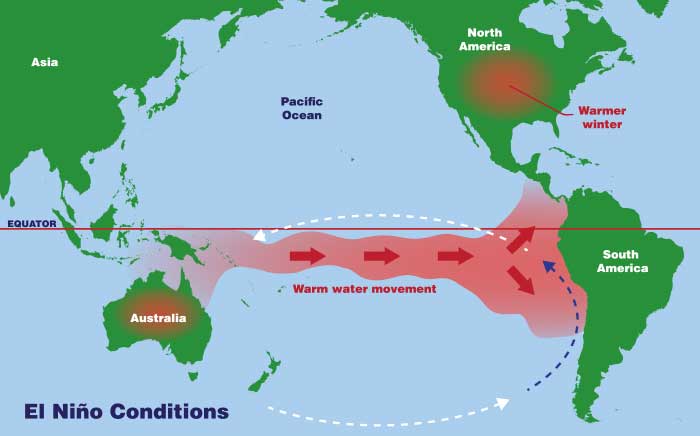
The largest effect is on South America, where the warmer water evaporates more and causes a lot more rainfall, but weather over much of the world is also affected.

Computer models predict that this year’s El Niño could be the strongest in many years, and could have a big effect on weather if it continues to build into the fall and winter as predicted. Among the predictions:
– It could take a big bite out of the drought in California and Arizona — a strong El Niño is associated with up to a 174% increase in precipitation in California;
– Fewer hurricanes in the Atlantic than usual;
– Fewer tornadoes than usual in the mid-west;
– A milder than normal winter for much of the US.
– On the flip side, they predict an “extremely active Pacific typhoon season”. There are some cool graphs and maps at the link at the top of this paragraph.
Most of this sounds good for us! The biggest worry is that the increased rainfall in California and the southwest could cause flooding damage and injuries. And then there’s this:
El Niño has an interesting effect on overall global temperatures. See the graphs below.
The top graph shows global temperatures. The bottom graph shows sea temperature deviations in the eastern Pacific; red is warmer than average and blue is cooler than average.

Note how global temperatures tend to rise during an El Niño, and dip during La Niña. Note the spikes in the lower graph, particularly in 1973, 1983 and 1998. In each case the global temperatures hit a new high, and then plunged for several years afterwards. The strongest El Niño event in recent history occurred in 1998, and is associated with the highest average global temperatures ever recorded. The El Niños since then have been milder, and the La Niñas unabated, causing some observers to speculate that the rise in global temperatures has stopped. But in the long view, 1998 is clearly an outlier event caused by that year’s El Niño, with the general trend unaffected. If this year’s El Niño turns out to be as strong as predicted, we should set new records.
Tags: Computers, Tech & Science











